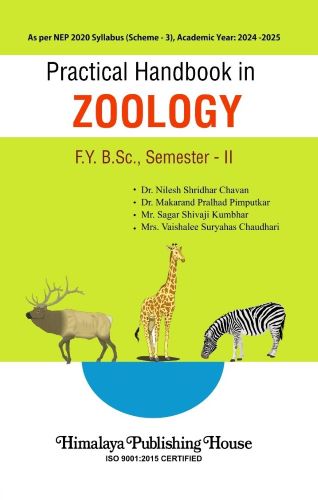It gives us immense pleasure to present this practical handbook in Zoology, designed to complement the MJ2 (Ecology and Biodiversity) course. This manual aims to provide learners with hands-on experiences in the fascinating and diverse realms of zoological sciences, focusing on core topics such as population dynamics, animal behaviour, biodiversity, and their critical interrelationships with human welfare.
The primary objective of this handbook is to equip learners with foundational and advanced practical skills in understanding and analysing ecological and biodiversity related phenomena. The topics and methodologies included herein have been carefully selected to give students comprehensive exposure to modern techniques in zoological research and ecological monitoring.
This Handbook has covered practical modules on avian, herpetofaunal, and mammalian fauna providing students with insights into the diversity, ecology, and adaptive strategies of these groups. The use of GPS tracking and remote sensing equips learners with modern tools for mapping and studying habitats, tracking species movements, and understanding habitat fragmentation. Topics such as population measurement methods and r/K selection analysis offer a foundation for understanding how species populations fluctuate and adapt in varying ecological conditions. Hydrological analysis and studies of aquatic fauna introduce students to freshwater and marine ecosystems, emphasizing their biodiversity, ecological roles, and conservation challenges. Modules on animal behaviour and parasitology delve into the intricacies of interactions within and between species, shedding light on their roles in evolution and ecological balance. Analytical methods like chromatography and colorimetry provide learners with practical tools for studying biological samples, enhancing their research capabilities in biochemistry and environmental monitoring.
This handbook underscores the rich biodiversity of India and its critical significance for ecological stability, human welfare, and sustainable development. By developing skills in modern ecological and zoological methodologies, learners are empowered to contribute to the conservation of biodiversity and to address pressing environmental challenges.
Contents –
1. Identification of Mammalian Fauna, Avian Fauna, and Herpetofauna of India (with Common Examples)
2. Study of Various Animal Tracking Systems – Global Positioning System (GPS), Remote Sensing, and Biotelemetry
3. Effect of Climate Change on Biodiversity: Case Study
4. Population Estimation Through Capture-Recapture Method
5. Study of r/K Selection in Various Species
6. Determination of Hardness of Water
7. Determination of Dissolved Oxygen (DO) of Water: Titrimetric Method/Winkler’s Method
8. (A) Determination of Salinity of Water Sample by Argentometric Method
(B) Determination of Salinity of the Water Sample by Refractometer
9. Study of Population Dynamics, Food Chain, and Food Web in Grassland, Forest, Desert, and Aquatic Ecosystems
10. Study of Animal Interaction
11. Estimation of Water Holding Capacity of a Given Soil Sample
12. Study of Animal Community Structure Using the Quadrate Method
13. Study of Aquatic Fauna and Their Ecological Role
14. Study of the Ecological Role of Characteristic Animal Species in Terrestrial Environments
15. Identification, Biology and Ecological Role of Pangolin, Blind Cave Fish, and Ganges Dolphin
16. Paper Chromatography for Separation of Amino Acids
17. Separation of Lipids by Thin Layer Chromatography (TLC)
18. Separation of Pigments by Chalk Chromatography
19. Measurement of Optical Density Using Colorimeter
EXERCISE: Study of IUCN Red Data Book Status of Brand Animals in India






